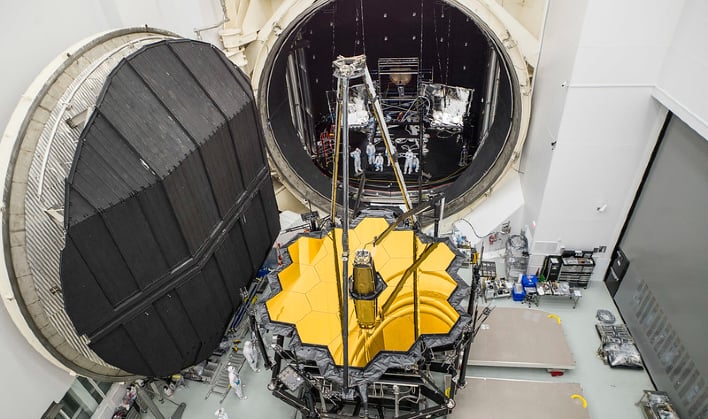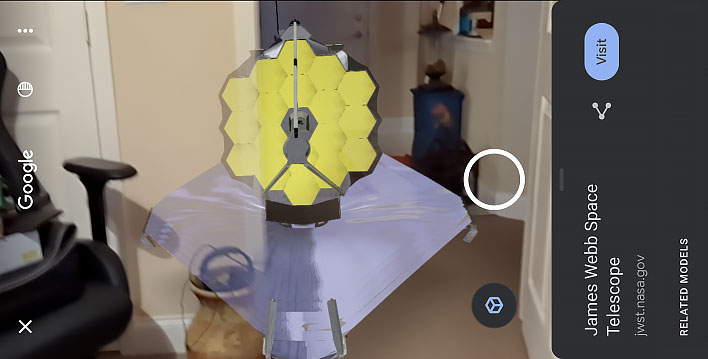Webb Telescope App Let's You Explore NASA's Massive Space Instrument In Your Own Back Yard

The James Webb Space Telescope (JWST) is scheduled to launch in just under two weeks on December 22nd. It is going to be the world's largest and most complex telescope ever to be placed into space. The telescope recently completed a 5,800 mile journey that began in California and ended in French Guiana 16 days later, located on the northeastern coast of South America. After arriving, the telescope has been undergoing preparations that are expected to last 55 days before its launch into space.
The preparations have not been as smooth as NASA would have hoped, however. While preparing to mount the JWST to the vehicle adapter, which is used to connect the JWST with the upper stage of the Ariane 5 rocket, an unplanned release of a clamp band occurred. This caused NASA to delay the initial launch date of December 18th in order to ensure the safety of the mission.
Regardless, it seems as though NASA has determined that all is well as they have reset the date for launch to December 22nd. This is good news to all those who have been both working on the project, and those who have been anticipating its launch, but it is the launch and the 29 days following it that will more than likely be tense for all those spectators and NASA engineers alike.
And NASA is building up the hype surrounding the JWST, with a phone app that will allow users to use Augmented Reality (AR) and place the telescope on any flat surface through their phone camera. You can make the telescope smaller or larger and also rotate it to get the best view of it possible. So, whether you want to place it on your dining room table, or fill up your backyard with it, NASA has you covered.

Intricate Sequence Of Events Needs To Be Precisely Coordinated For The Webb Space Telescope Team
Once the telescope completes 206 seconds of flight, at an altitude of about 75 miles above the atmosphere, the observatory will be separated from the two halves of the rocket fairing that shields the observatory during ascent. Shortly after, ground teams will await communication from JWST. At this point Webb will separate from the launch vehicle approximately 28 minutes after launch, and from this moment on, the ground team at the Space Telescope Science Institute in Baltimore will be in full control. This will also be the beginning of the most complex sequence of deployments ever attempted in a single space mission.Approximately 31 to 33 minutes after launch, Webb will extend its solar array, stopping the drain on the observatory's internal battery. This will ensure it can power the highest data rate communication to the ground through NASA's Deep Space Network (DSN). The onboard medium and high-gain antenna will deploy at the 2 hour mark.
After passing the Moon nearly two and a half days following launch, JWST will perform its first large deployment, the extension of its sunshield frame known as a utilized pallet structure. It will fold down nearly three days after launch, opening the observatory up to continue expanding. This marks the beginning of all major deployments and is set to take approximately five hours for both front and back pallets to fold down completely. At four days a deployable tower will extend to separate the telescope mirrors and instruments from the spacecraft bus. It is this separation that will effectively isolate the telescope from possible vibrations and conducted heat coming from the spacecraft bus.
Around 5 days after launch, the sunshield membrane deployments begin as the special covers that protect the sunshield during ascent will roll out of the way. Following this is a vital and critical point in the mission when all of the 107 sunshield release mechanisms are required to fire on cue and pull themselves out to free the membranes. Once this is completed, two wings known as mid-booms extend to pull each of the sunshield layers out into their characteristic diamond shaped formation nearly a day later. Once full deployment has been achieved, each of the five layers are tensioned and separated using special pulleys and motor systems. This part of the deployment should be completed around day 8 or 9 post launch.
After the conclusion of the sunshield tensioning, a special radiator behind the primary motor is deployed to enable extra cooling for the scientific instruments. The next step is when JWST's optics, and NASA's eye on the cosmos open up. One of the most important deployments will take place on the tenth day, which will include the telescope deployment which will latch into place the tripod holding the crucial secondary mirror. The Primary mirror is set to deploy on the 12th day and at 13 days Webb's large-scale deployments are expected to conclude with the locking in of its primary mirror wings.
The days leading up to day 29 will be include a multi-step process to move all 18 primary mirror segments out of their launch configuration. This will also be when 126 extremely precise actuators on the backside of the mirrors will position and bend or flex each mirror into a specific prescription, a process that will last months. Then on day 29, the team will fire the thrusters on JWST once again in order to place it into its prescribed orbit at the second Lagrange point, or L2, nearly one million miles away.
It is easy to see how much work and dedication has been put into The James Webb Telescope. It is also easy to understand why the team back here on Earth will be on the edge of their seats as they watch each and every small part move into place over a period of days following launch. With this being a one shot deal, NASA and the rest of the world watching are hoping everything works as it was designed to. Until then, you can enjoy the Augmented Reality view of the telescope in the comfort of your home.
Be sure to continue following HotHardware, as we will be watching for any events leading up to launch and taking a more in-depth peek at what JWST will be looking at as it travels through space.

